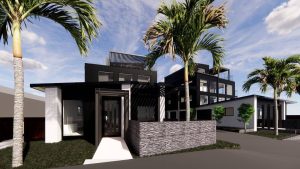The below article featured in the The New Zealand Herald 17 January 2022.
28-year-old developers plan $55m scheme in blue-ribbon Auckland area
Two 28-year-old developers are planning a $55 million housing project in one of the country’s most expensive suburbs. But because their scheme doesn’t comply fully with the Auckland Unitary Plan, a limited number of people are being invited to give feedback by early next month. Matthew Horncastle and Blair Chappell of Williams Corporation want to build a 12-apartment scheme on a vacant site at 16 Shelly Beach Rd, St Mary’s Bay, on the road which leads up to Jervois Rd from the motorway.
 The wider Herne Bay area has been named New Zealand’s most expensive.
The wider Herne Bay area has been named New Zealand’s most expensive.
Plans are with Auckland Council but limited notification has been called by February 9 due to a number of plan breaches. “The site is consented for an apartment building,” Horncastle said. “We believe it is better used for luxury townhouses. We are in the process of consenting these and have larger customer demand for townhouses over apartments.” A property to the west and north were deemed to be affected, hence the limited notification. The 1770sq m site is beneath and beside the 16-level tower Westwater, 10 Shelly Beach Rd.
The application from Auckland’s Hamish Anderson, a senior planner at Christchurch headquartered consultants Novo Group, showed how the scheme had been conceived. Anderson said he was talking to neighbours about how any issues could be avoided. “Adverse effects have been minimised and managed with the layout and orientation of the buildings which reflect the shape of the lot. From the street, the development presents as two buildings that are, initially single storey in height, but with that height increasing further into the site. In addition, when viewed from the road boundary, there is appropriate modulation and materiality provided,” his application said.
The buildings have been designed not to dominate the street frontage. The landscape planting, at the front of the site provides additional softening of the appearance, he said. Marginal infringements are proposed in a relation to some aspects of restrictions on the site. The council’s discretion is needed because the Auckland Unitary Plan’s maximum 70 per cent impervious site coverage will be breached by 73 per cent coverage.
Total site coverage is set at 50 per cent but Williams’ scheme is to cover 53.9 per cent of the site. The proposed 26.3 per cent landscaping area is below the threshold 30 per cent minimum in the plan. The scheme represents an early but not isolated example of residential intensification in the area, Anderson’s application said.
There are similar developments along Shelly Beach Rd and particularly at 32 Shelly Beach Rd which is now being developed “as well as the tower block immediately to the south”, Novo’s application said referring to the neighbouring high-rise. The scheme is for two blocks and its form will be broken up by using a mix of materials, modulation in facades and variations in the roof form. Being only three levels high means the project will achieve a human scale, below the permitted maximum height limit, Novo said. Nine units have two car parks, one has three and two have one. Babbage Consultants did the scheme plan for the land.
A front corner unit is 76sq m but the largest is 309sq m and the others are around 200sq m each. CoreLogic says Herne Bay remains the highest priced suburb in Auckland and New Zealand, with a median property value now of $3.61m. There are 28 suburbs across Auckland with a median value at least $2m and 153 in the $1m-$2m range. That is only 26 less than $1m, and three less than $700,000 which are Grafton, Manukau and Auckland Central.
Horncastle, headquartered in Christchurch, told the Herald on Saturday he plans to keep one of the places as his Auckland home. Williams Corporation was named by BCI Central’s latest report as second only to the franchised national housebuilder G.J. Gardner. Williams is now the second-largest housebuilder by annual number of homes completed but Horncastle says it’s the biggest privately owned house builder in New Zealand. In 2018 when they were both aged 24, the company built just 40 homes in the inner Christchurch city and surrounding suburbs and sold 80, with an overall sales value of about $35m. But last year, it was second only to the powerhouse of the sector and built 761 homes in the year to October 2021 for $107m, selling houses for what might seem like an unbelievably low average $141,164. It doesn’t include the land.
In 2019, Williams Corporation Capital was founded and now has $145m funds of which Williams has around $130m drawn. Qualifying wholesale investors are drawn to a 10 per cent guaranteed return. In the year to October 2021, Williams built 761 homes, mostly townhouses. G.J. Gardner built 1645 homes and, although Williams’ output is less than half the largest builder, it’s been a steep rise.




